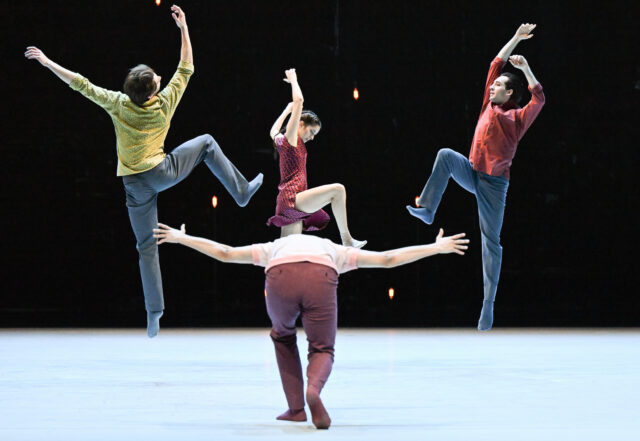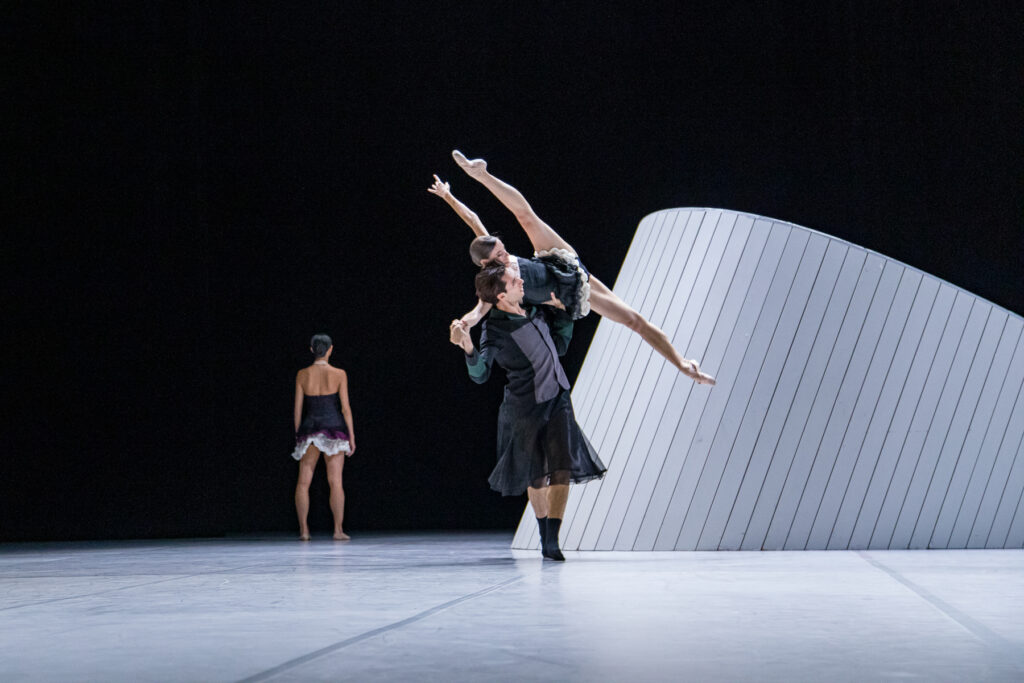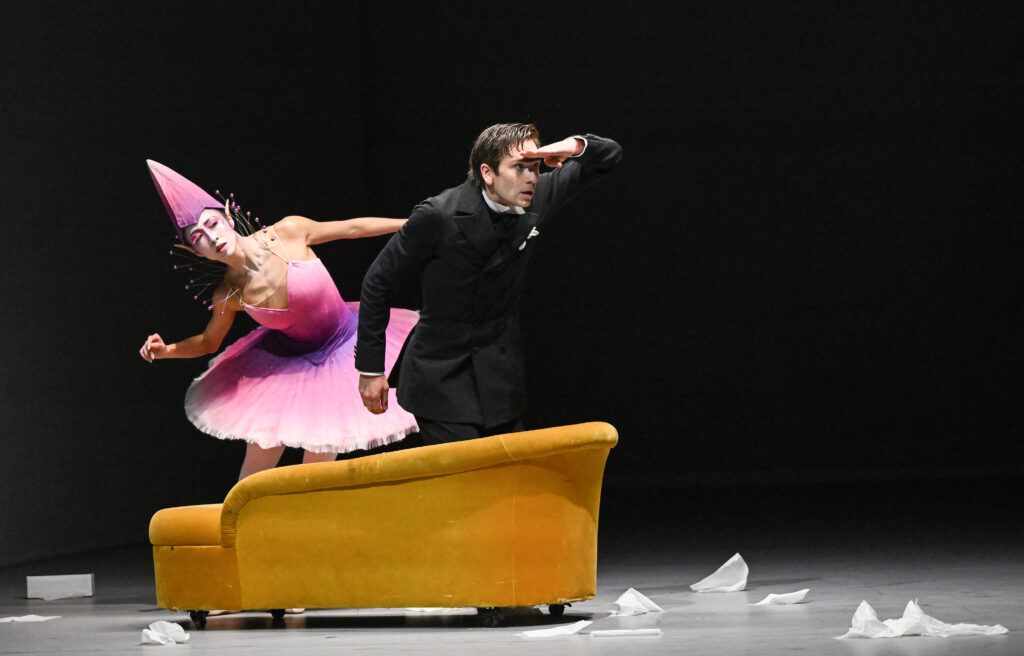
BERLINO – Dal 22 al 24 settembre 2022, presso la Big Arena Tempodrom, nell’ambito del programma della Deutsche Oper Berlin, si è esibito lo Stuttgart Ballet. La serata, dal titolo Pure Bliss (pura beatitudine), ha visto la compagnia di Stoccarda esibirsi in tre pezzi del coreografo svedese Johan Inger.
Il primo è Bliss, creato nel 2016 per l’Aterballetto.
La coreografia è gioiosa, dinamica, brillante e con numerosi cambi di ‘formazione’. Si passa continuamente da duetti a soli e da parti in sincro a momenti corali che danno ritmo e varietà allo spettacolo. Nonostante la naturalezza e la vivacità dell’esecuzione, il pezzo, montato sul Köln Concert di Keith Jarrett, presenta molti passaggi tecnici e richiede grande precisione per il modo in cui è strutturato nello spazio. Rotolate, corse, salti, prese e repentini cambi di direzione danno vita a un’esibizione allegra e piena di brio. Nel finale, agli otto protagonisti di Bliss si aggiungono altri otto ballerini che entrano uno dopo l’altro per un finale trionfale.
Il secondo pezzo è Out of Breath (Senza fiato), creato nel 2002 per la Nederlands Dans Theater II.
In questo caso la coreografia è accompagnata da musica eseguita dal vivo. I due brani, firmati da Jacob Ter Veldhuis e Félix Lajkó, sono drammatici e intensi. Giocando con una parete a forma di onda, che i ballerini saltano, scavalcano, usano come sponda per effettuare salti, camminate aeree, o usano come nascondiglio, Johan Inger riesce a trasmettere lo stesso pathos e la medesima sensazione oscura che suscitano le note dell’orchestra. Dopo la leggerezza di Bliss, nonostante la bellezza di alcuni passaggi e delle parti più teatrali, in cui anche l’interpretazione dei sei ballerini diventa più coinvolgente, Out of Breath risulta essere più incentrato sui tecnicismi e sull’estetica della danza che non nell’emozione drammaturgia del pezzo.
L’ultima performance ad andare in scena, creata appositamente per lo Stuttgart Ballet, è Aurora’s nap (Il pisolino di Aurora).
Se l’evidente riferimento alla famosa opera di repertorio La bella addormentata può far pensare a un pezzo squisitamente classico, i numerosi virtuosismi sono solo una parte dell’ironica interpretazione in chiave contemporanea della fiaba. Il pubblico segue divertito le variazioni delle fate e i goffi movimenti del papà che fa continuamente volare la neonata dalle sue braccia. Ride a crepapelle per i buffi pretendenti della giovane fanciulla o per le incursioni sul palco di personaggi di altre favole. Poi, quando Aurora si addormenta si cambia atmosfera e si fa un salto negli anni 60, finché un principe dei nostri tempi non rompe l’incantesimo con un bacio e inizia il duetto tra i due innamorati. Lo spettacolo è davvero spassoso, ma anche tecnicamente impegnativo.
Bravissimi i ballerini dello Stuttgart Ballet che dimostrano di essere versatili e convincenti in tutti e tre i pezzi. Interessante l’esperimento di ‘pura beatitudine’, che mette insieme tre coreografie dello stesso autore con un carattere tanto diverso tra loro.

From September 22nd to 24th, as part of the Deutsche Oper Berlin program, the Stuttgart Ballet performed at the Big Arena Tempodrom. The evening, titled Pure Bliss, saw the Stuttgart company performing three pieces by Swedish choreographer Johan Inger.
The first is Bliss, created in 2016 for Aterballetto.
The choreography is joyful, dynamic, brilliant and with numerous ‘formation’ changes. There is a continuous shift from duets to solos and from parts in sync to choral moments that give rhythm and variety to the show. Despite the naturalness and vivacity of the execution, the piece, on Keith Jarrett’s Köln Concert, has many technical passages and requires great precision due to the way it is structured in the space. Rolls, runs, jumps, lift and sudden changes of direction give life to a cheerful and lively performance. In the end, the eight protagonists of Bliss are joined by eight other dancers who enter one after the other for a triumphal finale.
The second piece is Out of Breath, created in 2002 for the Nederlands Dans Theater II.
The choreography is accompanied by live music. The two pieces, signed by Jacob Ter Veldhuis and Félix Lajkó, are dramatic and intense. Playing with a wave-shaped wall, which the dancers jump, climb over, use as a bank to perform jumps, aerial walks, or use to hide themselves, Johan Inger manages to convey the same pathos and the same dark sensation that the notes of the orchestra produce. After the lightness of Bliss, despite the beauty and content of some passages and of the more theatrical parts, in which even the interpretation of the six dancers becomes more engaging, other parts of the choreography feel more focused in the virtuosism of the technique and not in the depth of the emotion.
The latest performance to go on stage, created especially for the Stuttgart Ballet, is Aurora’s nap.
Even if the obvious reference to the famous repertoire piece The Sleeping Beauty may suggest an exquisitely classic piece, the numerous virtuosities are only part of the ironic interpretation in a contemporary key of the fairy tale. The audience follows with amusement the variations of the fairies and the clumsy movements of Aurora’s father, who continually makes the baby fly from his arms. People laugh out loud for the funny suitors of the young girl or for the forays on stage of characters from other fairy tales. Then, when Aurora falls asleep, the atmosphere changes and takes a leap into the 60s, until a ‘prince’ of our time, breaks the spell with a kiss and a duet between the two lovers begins. The show is really hilarious, but also technically demanding.
The Stuttgart Ballet dancers are very good, proving to be versatile and convincing in all three pieces. The experiment of Pure Bliss is interesting, for bringing together three choreographies by the same author with such a different character.















































